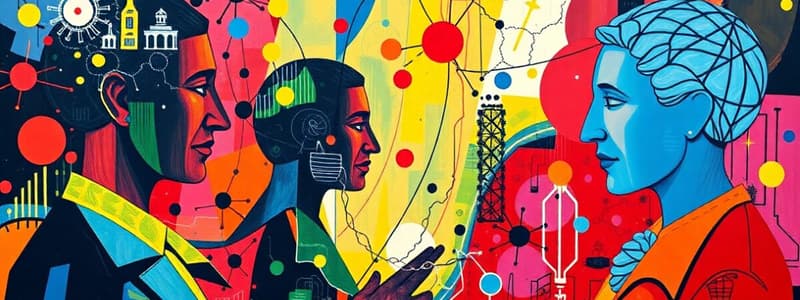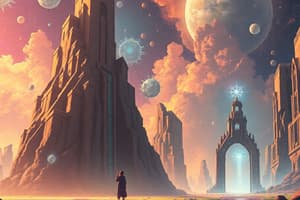Podcast
Questions and Answers
What was one of the primary purposes of establishing the Philippine Normal School?
What was one of the primary purposes of establishing the Philippine Normal School?
- To provide training for Filipino teachers. (correct)
- To create a college for the arts.
- To promote agricultural education.
- To facilitate American educational policies.
Which institution was created on 18 June 1908?
Which institution was created on 18 June 1908?
- Philippine Journal of Science
- Philippine Normal School
- University of the Philippines (correct)
- Bureau of Mines
What economic relationship did the Philippines maintain during this period?
What economic relationship did the Philippines maintain during this period?
- Self-sufficient agricultural production.
- Exports primarily of manufactured goods.
- Free trade relations with Spain.
- Economy tied to the United States. (correct)
Which agency was established to promote scientific research and economic growth?
Which agency was established to promote scientific research and economic growth?
What was a significant infrastructure development mentioned in the content?
What was a significant infrastructure development mentioned in the content?
Which college focused on agriculture was established in 1909?
Which college focused on agriculture was established in 1909?
During the establishment period, who primarily taught in higher education institutions?
During the establishment period, who primarily taught in higher education institutions?
What type of goods did the Philippines primarily import during this era?
What type of goods did the Philippines primarily import during this era?
What organization was created in 1901 to focus on agriculture in the Philippines?
What organization was created in 1901 to focus on agriculture in the Philippines?
Who is credited with discovering the solstice and equinox?
Who is credited with discovering the solstice and equinox?
Which disease was NOT researched by the Bureau of Science?
Which disease was NOT researched by the Bureau of Science?
What material was originally used to create paper in Ancient China?
What material was originally used to create paper in Ancient China?
What did the Bureau of Science publish starting in 1906?
What did the Bureau of Science publish starting in 1906?
When was gunpowder invented, and by whom?
When was gunpowder invented, and by whom?
Which institution was established to oversee the development of coconut research?
Which institution was established to oversee the development of coconut research?
Which Greek figure created an early version of a mechanical alarm clock?
Which Greek figure created an early version of a mechanical alarm clock?
What was a primary effect of the American introduction of secularized public-school education?
What was a primary effect of the American introduction of secularized public-school education?
Which of these commodities was studied for its commercial value by the Bureau of Science?
Which of these commodities was studied for its commercial value by the Bureau of Science?
What was the main purpose of the gnomon invented by Anaximander?
What was the main purpose of the gnomon invented by Anaximander?
Which significant development in transportation took place during the American regime in the Philippines?
Which significant development in transportation took place during the American regime in the Philippines?
Which civilization is linked to the discovery of paper before 105 AD?
Which civilization is linked to the discovery of paper before 105 AD?
What was a consequence of the Philippines' economic ties to the United States during the American regime?
What was a consequence of the Philippines' economic ties to the United States during the American regime?
What material were early mechanical clocks made from?
What material were early mechanical clocks made from?
Why did Aristotle conclude that the Earth must be a globe?
Why did Aristotle conclude that the Earth must be a globe?
What are chinampas primarily used for?
What are chinampas primarily used for?
What is the primary use of passion flower in medicine?
What is the primary use of passion flower in medicine?
What does 'Ayurveda' mean?
What does 'Ayurveda' mean?
What was a significant contribution of early medical colleges?
What was a significant contribution of early medical colleges?
Which ancient agricultural innovation is tied to religious rituals?
Which ancient agricultural innovation is tied to religious rituals?
What is one effect of passion flower, according to traditional medicine?
What is one effect of passion flower, according to traditional medicine?
Which area of study contributed to advancements in medicine and pharmacology?
Which area of study contributed to advancements in medicine and pharmacology?
What is the primary purpose of the religious festivals dedicated to Tonatiuh?
What is the primary purpose of the religious festivals dedicated to Tonatiuh?
What was the primary purpose of the 260-day religious calendar?
What was the primary purpose of the 260-day religious calendar?
Which of the following was NOT a key good exported in trade?
Which of the following was NOT a key good exported in trade?
What was the significance of cacao beans in the economy?
What was the significance of cacao beans in the economy?
What was one method used to maintain soil fertility?
What was one method used to maintain soil fertility?
What was chicha primarily used for in Inca society?
What was chicha primarily used for in Inca society?
Which architectural feature was commonly found in cities?
Which architectural feature was commonly found in cities?
What was the purpose of the Pok-Ta-Pok game?
What was the purpose of the Pok-Ta-Pok game?
Which animal was NOT raised for its wool in Inca agriculture?
Which animal was NOT raised for its wool in Inca agriculture?
What was the purpose of the Kurikantia Temple in Cusco?
What was the purpose of the Kurikantia Temple in Cusco?
Which item was commonly imported in trade?
Which item was commonly imported in trade?
What was a distinct feature of Chichen Itza?
What was a distinct feature of Chichen Itza?
What was one of the uses of quipu in Inca society?
What was one of the uses of quipu in Inca society?
What role did priests play in relation to the calendars?
What role did priests play in relation to the calendars?
Which of the following was considered more valuable than gold or silver by the Incas?
Which of the following was considered more valuable than gold or silver by the Incas?
What agricultural practice involved using fish heads and bird droppings?
What agricultural practice involved using fish heads and bird droppings?
Human sacrifices in Inca society were performed for what reason?
Human sacrifices in Inca society were performed for what reason?
Flashcards
Ancient Chinese Paper
Ancient Chinese Paper
Paper existed in ancient China around 100 BC, made from mulberry tree bark, later strengthened with hemp and fishnets.
Ancient Chinese Earthquake Prediction
Ancient Chinese Earthquake Prediction
Ancient Chinese used a dragon-like device to predict earthquakes, with the dragon's movements correlating with the direction of the quake.
Anaximander's Contribution
Anaximander's Contribution
Anaximander (611-547 BC) created a sundial gnomon and a map of the known world. This shows his contributions to timekeeping and cartography.
Gunpowder Invention
Gunpowder Invention
Signup and view all the flashcards
First Mechanical Clock (Europe)
First Mechanical Clock (Europe)
Signup and view all the flashcards
Aristotle's Earth Shape
Aristotle's Earth Shape
Signup and view all the flashcards
Ctesibius' Alarm Clock
Ctesibius' Alarm Clock
Signup and view all the flashcards
Yi Xing's Mechanical Clock
Yi Xing's Mechanical Clock
Signup and view all the flashcards
Public School System
Public School System
Signup and view all the flashcards
Philippine Normal School
Philippine Normal School
Signup and view all the flashcards
University of the Philippines (UP)
University of the Philippines (UP)
Signup and view all the flashcards
Economic Development
Economic Development
Signup and view all the flashcards
Weather Bureau
Weather Bureau
Signup and view all the flashcards
Board/Bureau of Health
Board/Bureau of Health
Signup and view all the flashcards
Bureau of Mines
Bureau of Mines
Signup and view all the flashcards
Infrastructure Advancements
Infrastructure Advancements
Signup and view all the flashcards
Bureau of Science
Bureau of Science
Signup and view all the flashcards
Philippine Journal of Science
Philippine Journal of Science
Signup and view all the flashcards
What did the Bureau of Science research?
What did the Bureau of Science research?
Signup and view all the flashcards
American influence on Philippine education
American influence on Philippine education
Signup and view all the flashcards
Philippine economic development during American rule
Philippine economic development during American rule
Signup and view all the flashcards
What were the key advancements in transportation and communication?
What were the key advancements in transportation and communication?
Signup and view all the flashcards
What were the consequences of the Philippine economy being tied to the United States?
What were the consequences of the Philippine economy being tied to the United States?
Signup and view all the flashcards
Key government institutions for science and technology
Key government institutions for science and technology
Signup and view all the flashcards
Mayan Calendars
Mayan Calendars
Signup and view all the flashcards
Mayan Currency
Mayan Currency
Signup and view all the flashcards
Mayan Trade Practices
Mayan Trade Practices
Signup and view all the flashcards
Mayan Forest Gardening
Mayan Forest Gardening
Signup and view all the flashcards
Mayan City Design
Mayan City Design
Signup and view all the flashcards
Chichen Itza's Pyramid
Chichen Itza's Pyramid
Signup and view all the flashcards
Cenotes and Maya
Cenotes and Maya
Signup and view all the flashcards
Pok-Ta-Pok: The Ball Game
Pok-Ta-Pok: The Ball Game
Signup and view all the flashcards
Inca Irrigation
Inca Irrigation
Signup and view all the flashcards
Inca Wetland Reclamation
Inca Wetland Reclamation
Signup and view all the flashcards
Inca Soil Enrichment
Inca Soil Enrichment
Signup and view all the flashcards
Inca Crop Rotation
Inca Crop Rotation
Signup and view all the flashcards
Inca Livestock
Inca Livestock
Signup and view all the flashcards
Inca Religious Practices
Inca Religious Practices
Signup and view all the flashcards
Inca Record-Keeping
Inca Record-Keeping
Signup and view all the flashcards
Inca Human Sacrifices
Inca Human Sacrifices
Signup and view all the flashcards
Chinampas
Chinampas
Signup and view all the flashcards
Cacao
Cacao
Signup and view all the flashcards
Ayurveda
Ayurveda
Signup and view all the flashcards
Holistic Healing
Holistic Healing
Signup and view all the flashcards
Sun Worship
Sun Worship
Signup and view all the flashcards
Tonatiuh
Tonatiuh
Signup and view all the flashcards
Calendrical Observances
Calendrical Observances
Signup and view all the flashcards
Ayurveda's Key Areas
Ayurveda's Key Areas
Signup and view all the flashcards
Study Notes
Science, Technology, & Society Course Outline
- 1.0 Historical Antecedents: Covers ancient times, Middle Ages, Renaissance, Scientific Revolution, and Industrial Revolution, focusing on technology's evolution. Includes the Modern Era and technology's development in the Philippines.
Intellectual Revolutions Defining Society
- 2.0 Intellectual Revolutions: Explores intellectual revolutions such as Copernican, Darwinian, and Freudian. Also examines contributions from Meso-America, Asia, the Middle East, and Africa.
Science and Technology for Nation-building
- 3.0 Science & Technology for Nation-building: Covers main modules relating to science education in the Philippines and major development programs and personalities in S&T. There is a section on S&T for nation-building.
Science & Technology and the Human Condition
- 4.0 Science & Technology and the Human Condition: Discusses technology as a tool for understanding the human condition, explores the concept of a good life, and examines the intersection of technology and humanity.
Studying That Suits You
Use AI to generate personalized quizzes and flashcards to suit your learning preferences.




